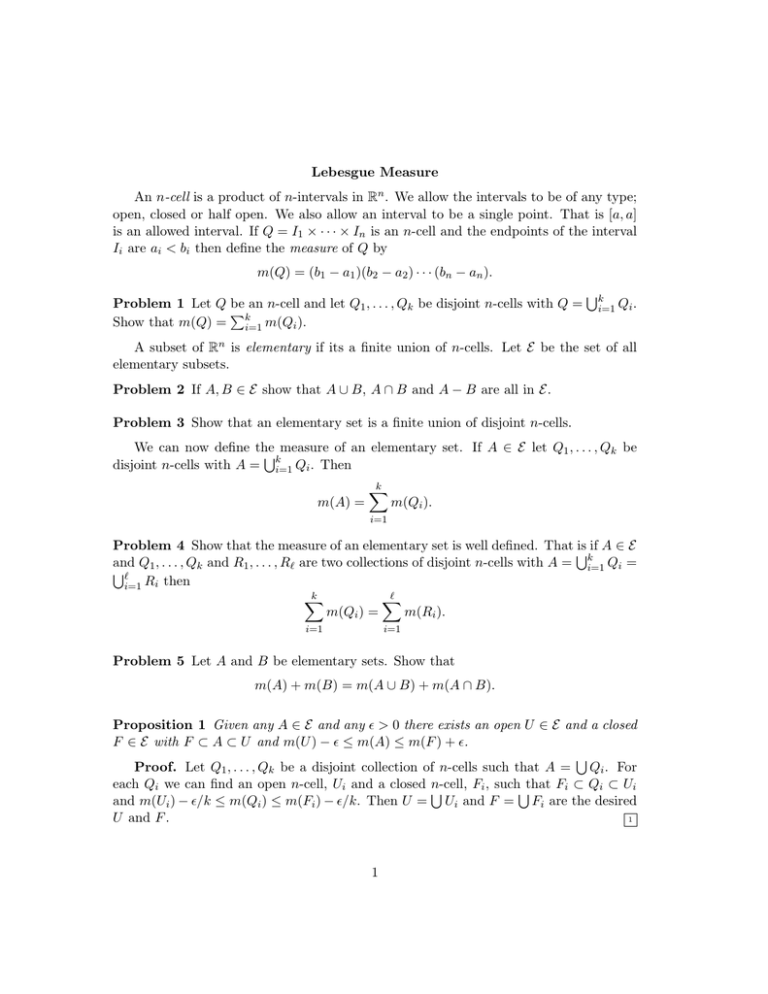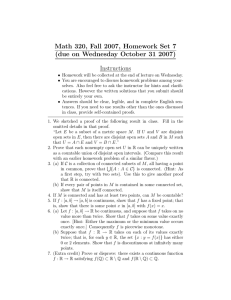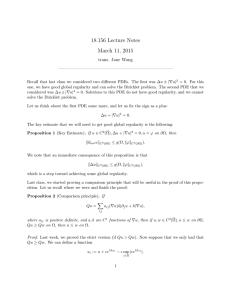Lebesgue Measure An n-cell is a product of n-intervals in R
advertisement

Lebesgue Measure
An n-cell is a product of n-intervals in Rn . We allow the intervals to be of any type;
open, closed or half open. We also allow an interval to be a single point. That is [a, a]
is an allowed interval. If Q = I1 × · · · × In is an n-cell and the endpoints of the interval
Ii are ai < bi then define the measure of Q by
m(Q) = (b1 − a1 )(b2 − a2 ) · · · (bn − an ).
Problem 1 Let Q be an n-cell and let Q1 , . . . , Qk be disjoint n-cells with Q =
P
Show that m(Q) = ki=1 m(Qi ).
Sk
i=1 Qi .
A subset of Rn is elementary if its a finite union of n-cells. Let E be the set of all
elementary subsets.
Problem 2 If A, B ∈ E show that A ∪ B, A ∩ B and A − B are all in E.
Problem 3 Show that an elementary set is a finite union of disjoint n-cells.
We can now define the
S measure of an elementary set. If A ∈ E let Q1 , . . . , Qk be
disjoint n-cells with A = ki=1 Qi . Then
m(A) =
k
X
m(Qi ).
i=1
Problem 4 Show that the measure of an elementary set is well defined. That S
is if A ∈ E
and Q1 , . . . , Qk and R1 , . . . , R` are two collections of disjoint n-cells with A = ki=1 Qi =
S`
i=1 Ri then
k
`
X
X
m(Qi ) =
m(Ri ).
i=1
i=1
Problem 5 Let A and B be elementary sets. Show that
m(A) + m(B) = m(A ∪ B) + m(A ∩ B).
Proposition 1 Given any A ∈ E and any > 0 there exists an open U ∈ E and a closed
F ∈ E with F ⊂ A ⊂ U and m(U ) − ≤ m(A) ≤ m(F ) + .
S
Proof. Let Q1 , . . . , Qk be a disjoint collection of n-cells such that A = Qi . For
each Qi we can find an open n-cell, Ui and a closed n-cell,
Fi , suchSthat Fi ⊂ Qi ⊂ Ui
S
and m(Ui ) − /k ≤ m(Qi ) ≤ m(Fi ) − /k. Then U = Ui and F = Fi are the desired
U and F .
1
1
We can now define the measure of an arbitrary subset of Rn . If A ⊂ Rn define
∗
m (A) =
A⊂
inf
S
∞
Ai ∈E
i=1
∞
X
Ai
m(Ai ).
i=1
is open
If A is an elementary set then this gives a new way of defining the measure of A. We
need to see that both ways give the same answer.
Proposition 2 If A ∈ E then m∗ (A) = m(A).
Proof. By Proposition 1 for all > 0 there is an open U ∈ E such that A ⊂ U
and m(A) ≥ m(U ) − . Then m(U ) ≥ m∗ (A) so m(A) ≥ m∗ (A) − . As this is true for
arbitrary > 0 we must have m(A) ≥ m∗ (A).
Applying Proposition 1 again we have a closed n-cell F with F ⊂ A and m(A) ≤
m(F ) + /2. By the definition of S
m∗ (A) we can also P
find a countable collection of open
elementary sets Ai such that A ⊂ Ai and m∗ (A) ≥ m(Ai ) − /2. The set F is closed
and bounded so it is compact.
S It is also covered by the open set Ai so there is a finite
subset of the Ai with F ⊂ ki=1 Ak and therefore
m(F ) ≤ m
k
[
k
X
!
Ai
≤
i=1
m(Ai ) ≤
i=1
∞
X
m(Ai ).
i=1
Combing the inequalities we have
m(A) ≤ m(F ) + /2 ≤
∞
X
m(Ai ) + /2 ≤ m∗ (A) + .
i=1
As this holds for all > 0 we have m(A) ≤ m∗ (A) finishing the proof.
Proposition 3 If A =
S∞
i=1 Ai
then m(A) ≤
2
P∞
i=1 m(Ai ).
Proof. We can assume the sum is finite for otherwise the propositionSis obviously
true. Fix an > 0. Let Aij be open elementary sets such that Ai ⊂ ∞
j=1 Aij and
P
i . Since
m(Ai ) ≥ ∞
m(A
)
−
/2
ij
j=1
A⊂
∞
[
i=1
Ai ⊂
∞
[
∞
[
i=1
2
j=1
Aij
and there are a countable number of Aij we have
∞
∞
∞
∞
∞
∞
X
X
X
X
X
X
m(A) ≤
m(Aij ) =
m(Aij ) ≤
m(Ai ) +
/2i =
m(Ai ) + .
i,j=1
i=1
j=1
Since was arbitrary we have m(A) ≤
i=1
P∞
i=1 m(Ai )
i=1
i=1
as desired.
3
Define the symmetric difference of two sets A and B by
S(A, B) = (A − B) ∪ (B − A).
We then define a distance between two sets by
d(A, B) = m(S(A, B)).
We can use d(, ) to define a notion of convergence for sets. Namely Ai → A if the
d(Ai , A) → 0 as i → ∞. Note that, unlike convergence for points, it can happen that
Ai → A and Ai → A0 but A 6= A0 .
Problem 6 Show that
S(A1 ∪ A2 , B1 ∪ B2 )
S(A1 ∩ A2 , B1 ∩ B2 ) ⊂ S(A1 , B1 ) ∪ S(A2 , B2 )
S(A1 − A2 , B1 − B2 )
and that
d(A1 ∪ A2 , B1 ∪ B2 )
d(A1 ∩ A2 , B1 ∩ B2 ) ≤ d(A1 , B1 ) + d(A2 , B2 ).
d(A1 − A2 , B1 − B2 )
Also show that
S(A, C) ⊂ S(A, B) ∪ S(B, C)
and that
d(A, C) ≤ d(A, B) + d(B, C).
Lemma 4
1. For any two sets A, B we have |m(A) − m(B)| ≤ d(A, B).
2. If Ai → A then m(Ai ) → m(A).
3
Proof of (a). Without loss of generality we assume m(A) ≥ m(B). By the previous
problem
d(A, ∅) ≤ d(A, B) + d(B, ∅).
Since d(X, ∅) = m(X) for any set X and m(A) ≥ m(B) we have
0 ≤ m(A) − m(B) ≤ d(A, B)
or |m(A) − m(B)| ≤ d(A, B).
(b). By (a), |m(A)−m(Ai )| ≤ d(A, Ai ). Since d(A, Ai ) → 0 we have m(Ai ) → m(A).
4
Define
MF = {A ⊂ Rn |there exists Ai ∈ E with Ai → A}
and
∞
[
(
M=
A ⊂ Rn |there exists Ai ∈ MF with A =
)
Ai
.
i=1
Proposition 5 Let A, B be in MF . Then
1. A ∪ B ∈ MF ;
2. A ∩ B ∈ MF ;
3. A − B ∈ MF ;
4. m(A ∪ B) = m(A) + m(B) − m(A ∩ B).
Proof of (a)-(c). Since A and B are in MF we have Ai and Bi in E with Ai → A
and Bi → B. By Problem 2, Ai ∪ Bi , Ai ∩ Bi and Ai − Bi are all in E. An application
of Problem 6 implies that Ai ∪ Bi → A ∪ B, Ai ∩ Bi → A ∩ B and Ai − Bi → A − B.
(d). Since the Ai and Bi are in E we have
m(Ai ) + m(Bi ) = m(Ai ∪ Bi ) + m(Ai ∩ Bi )
by Problem 5. As i → ∞ this becomes
m(A) + m(B) = m(A ∪ B) + m(A ∩ B)
by (b) of Lemma 4.
5
4
Lemma 6 Let A =
S∞
i=1 Ai
where the Ai are pairwise disjoint and in MF . Then
m(A) =
∞
X
m(Ai ).
i=1
P
Proof. We have already seen that m(A) ≤ ∞
) so we only need to reverse
i=1 m(A
Sk i
the inequality. By (1) of Lemma 5 the finite union Bk = i=1 Ai is in MF since the Ai are
P
in MF . Next we apply (4) of Lemma 5 to see that m(Bk ) = ki=1 m(Ai ). Since Bk ⊂ A
P
P
we have ki=1 m(Ai ) = m(Bk ) ≤ m(A). As all the terms in the series ∞
i=1 m(Ai ) are
non-negative and
P its partial sums are bounded above by m(A) we have that the series
converges and ∞
6
i=1 m(Ai ) ≤ m(A).
Lemma 7 Let A be a set in M. Then m(A) < ∞ if and only if A ∈ MF .
Proof. If A ∈ MF then there exists a B ∈ E such that d(A, B) < ∞. Since
A ⊂ B ∪ S(A, B) and m(B) < ∞ this implies that m(A) < ∞.
S
Now assume that m(A) < ∞. Since A ∈ M there are Ai ∈ MF with A = ∞
i=1 Ai .
S
Let Bk = ki=1 Ai . For i > 1 we define A0i = Bi − Bi−1 and for i = 1 we define A01 = A1 .
Applying (1) and (3) of Lemma 5 we see
Bi and A0i are in MF . The A0i are
P∞that the
0
disjoint and their union is A so m(A) = i=1 m(Ai ) by Lemma 6. We also have Bk → A
since
!
∞
∞
[
X
0
d(A, Bk ) = m(S(A, Bk )) = m
Ai =
m(A0i )
i=k+1
i=k+1
and the sum on the right limits to 0 as k → ∞ since it is the tail of a convergent series.
Note that the last equality is an application of Lemma 6.
Each Bi is in MF so we can find Ei ∈ E with d(Bi , Ei ) ≤ 2−i . Then
d(A, Ei ) ≤ d(A, Bi ) + d(Bi , Ei ) ≤ d(A, Bi ) + 2−i .
The right side of the inequality limits to 0 since Bi → A and 2−i → 0 and therefore
Ei → A and A is in MF .
6
Theorem 8 If A ∈ M and Ai ∈ M with the Ai disjoint and A =
m(A) =
∞
X
i=1
5
m(Ai ).
S∞
i=1 Ai
then
Proof. If m(Ai ) < ∞ for all i then by Lemma 7, Ai is in MF for all i and the
theorem follows from Lemma 6. If m(Ai ) = ∞ for some i then m(A) ≥ m(Ai ) is also
infinite and again the equality holds.
8
Theorem 9
1. If Ai ∈ M then
S∞
i=1 Ai
is in M.
2. If A and B are in M then A ∩ B is in M.
3. If A and B are in M then A − B is in M.
S
Proof of (1). Since Ai is in M there are Aij ∈ MF with Ai = ∞
j=1 Aij . Since a
countableScollection of countable sets is countable there are countably many Aij . Therefore A = ∞
i,j=1 Aij is in M.
(2) and (3). Let Ai and Bi be countable collections of sets in MF whose unions
are A and B, respectively. Then each Ai ∩ Bj is in MF by Lemma 5 and by (1) we have
that
∞
[
Ai ∩ B =
Ai ∩ Bj
j=1
is in M. Another application of (1) then gives us that
A∩B =
∞
[
Ai ∩ B
i=1
is in M.
For (3) we note that
A−B =
∞
[
Ai − B.
i=1
Since Ai − B = Ai − (Ai ∩ B) is in M the union is also in M.
6
9








